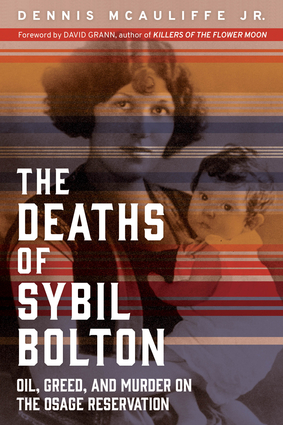
I spent last Thursday afternoon in a Brooklyn theater watching director and co-writer Martin Scorsese’s adaptation of David Grann’s Killers of the Flower Moon, and I feel comfortable saying that I’m an admirer of film and book alike. But it’s worth pointing out that Grann’s book — terrific as it is — is not the only literary work to deal with the horrific murders that were aptly known at the time as the Reign of Terror.
These books include John Joseph Matthews’s 1934 novel Sundown and several works by the late Fred Grove. In the fall of 2020, Chicago Review Press reissued journalist Dennis McAuliffe Jr.’s 1994 book The Deaths of Sybil Bolton, which explores McAuliffe’s investigation into the death of his Osage grandmother — one that was officially deemed to be suicide. If you’re familiar with the murders of dozens of members of the Osage Nation, you may be wondering about the veracity of that judgment — and it’s not really a spoiler to say that McAuliffe finds plenty of evidence that his grandmother was murdered.
To say that McAuliffe’s book is another compelling piece of a larger story is far from a controversial take — and it’s worth noting here that David Grann penned the introduction to the latest edition. “The work contains a moving autobiography along with a true whodunit,” Grann wrote. “And it serves as powerful testimony—testimony of one of the most sinister crimes in American history, which for too long has been erased from official accounts, like the death of Sybil Bolton. ”
Grann’s book does a fantastic job at switching between the human scale and the larger trajectory of events. It’s one of the things that he excels at as a writer, and one of the things that’s gotten his writing such a substantial audience over the years. McAuliffe is after something a little different here — his book also chronicles the events of the Osage Reign of Terror and the ways in which it finally came to an end. It’s in the ways that the two men — both skilled writers, both practiced in their chosen craft — differ that makes McAuliffe’s book especially powerful.
As someone with a direct familial connection to those events, McAuliffe is also able to address something that Grann isn’t — namely, what the effects of the murders of countless Osage had on their descendents. McAuliffe often yields the floor to his mother, who grew up knowing very little of her late mother’s history — and of what role her father may have played in her death.
In his introduction to this edition, Grann points to McAuliffe’s background as a journalist and editor, and you can feel McAuliffe’s experience and professional history take on a tactile quality in the first half of his book. But there are also glimpses of the psychological effects that his research into this story is taking on McAuliffe during that time, and eventually that thread of the book turns into something much bleaker — and reveals that this foray into his family’s tragic history has shockingly high stakes for its author.
For his part, McAuliffe is still chronicling the aftereffects of the tragic events of the 1920s — including a recent Washington Post article about the effects of the filming of Killers of the Flower Moon on the local community. For readers of McAuliffe’s earlier work, this new work also feels like an elegant postscript to that book — and a powerful reminder of the burden of history.
Follow Vol. 1 Brooklyn on Twitter, Facebook, and sign up for our mailing list.
